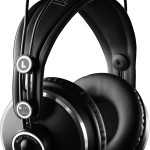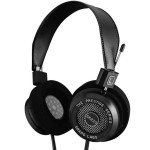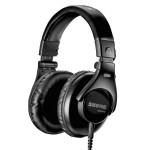What does one look for in a good set of studio headphones? Is it more important to have a flat frequency response or do you want more highs or lows? Open back or closed back? These are just a few of the questions that have been argued amongst musicians, engineers and producers for ages. As with most things, there is no one “right” answer. These are only guidelines and humble opinions on why a certain pair of headphones may be a better choice over another. Perhaps the most important question to answer is for what purpose the headphones will be used. For this particular special, we’ll compare six pairs of cans and how they fit into the realm of at-home mixing.
For the home studio recorder and avid music listener, there is a fine line between hype and what is actually audible. Every pair of headphones discussed has their pros and cons; don’t neglect the comfort level of each when making purchasing decisions. If long listening or mixing sessions come up, the comfort factor can play an increasingly important role. Our suggestion is to do your homework, read up on user reviews and narrow down your selection to at most three, but ideally two, models and try test them out in person. There are a million people out there with a million different opinions, but in the end, it’s your ears that will do the listening.
Perhaps the most comfortable of all the headphones on this list, the AKG K 271 MKII also provide a very wide range in terms of frequency response. Extending beyond the audible frequency a person’s own ears are capable of plays an important role in what headphones the at-home engineer selects. One cannot EQ what one cannot hear. Thanks to the design of this model, the listener gets isolation from the outside world while still maintaining a smooth, relatively open sound for closed-back headphones. Being able to collapse these headphones is another major plus and allows for easy portability. In the mobile engineer’s world, who might have a tracking session at one facility during the day with plans to mix the single at home that night, this portability goes a long way. The plushy comfort also becomes a factor for those long nights spent mixing a tune or for that 11-hour flight from Chicago to Moscow that you just can’t fall asleep on. The AKGs are a simply a comfortable, versatile option for the bedroom engineer and avid music listener.
As the only open-back headphones on this comparison list, the Grado SR225i models do have a slight edge in the overall listening experience. For obvious reasons (they are open-back headphones, after all) the Grados are the most “open” and rich sounding cans of all six we demo’d. Most producers and engineers agree that the open back provides a sound that’s more natural, and similar to what one would hear in a room listening to acoustic speakers. For the home mixing studio or even general listening, this “open” and airy sound should play a major role in selecting the SR225i pair as part of your setup. By having a similar vibe to what the musicians and their producer(s) had when making mixing decisions, the Grados will allow a listener to come closer to experiencing the song as the artist intended. In our humble opinion, these have perhaps the smoothest and most detailed frequency response of all the headphones being discussed. Perhaps what we love even more than the open sound is the feel of the foam material that lines the ears when wearing these retro-looking models.
One drawback to these against the others, however, occurs in a headphone-monitoring situation. As with almost all open-back designs, they will bleed into the microphone, especially with a vocalist. A drummer will also have to crank this pair since some of the live drum sound will bleed its way into the headphones as well. Fantastic for general listening and equally as good of a choice for mixing, one should use the Grados with caution while live monitoring as a recording musician.
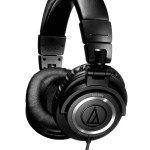 Audio-Technica ATH-M50
Audio-Technica ATH-M50
Price: $159
From microphones to headphones, Audio-Technica is a company that makes durable, long lasting products. The ATH-M50s are no exception. For the proud new owner of an Mbox or any other home studio interface, the M50s provide a great transition into mixing and listening on headphones. The extended high frequency range seems to actually provide a nicer, low end, if that makes sense. This may be due to sub-harmonics or it may be that the low end extends to 15 Hz. Not only is there a nice, big low end, the high frequencies are very natural and open sounding. While not quite as detailed as the other headphones on this list, the ATH-M50s are a perfect blend of home listening and home tracking headphones. The padding is comfortable, allowing for long listening or mix sessions. Outside noise is almost completely blocked out, making it much easier to tell your fiancée, roommate or anyone else yelling at you to stop the insanity – you REALLY could not hear them from the home studio. At a price point under $160, those looking to get serious for the first time could do a lot worse.
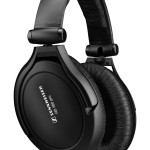 Sennheiser HD 380 Pro
Sennheiser HD 380 Pro
Price: $199
The funky angle of the cups against the headband of the HD 380 Pro headphones took us by surprise the first time we saw and used these. Once we got past this design quirk, we were itching to see what all the hype around E.A.R. was. To our surprise, the promise of a decreased comb filter effect and distortion was no lie. It was hard to tell if it was the increased low-end response or the lack of comb filtering that provided what felt like a surprisingly detailed low and low-mid frequency response. Being careful not to do damage to our ears, we took a very loud source and put the output up louder and louder and really had to crank these before we were able to get any clipping during a sample mixing session. Clarity of the signal and the ability to get loud without distorting were the two things that really stuck out for us while using the HD 380 PROs. The issue with loud volumes is that the detail tends to get lost as one increases volume – leading to painful clipping but also a muddied sound field, something you definitely need to avoid when editing tracks! Louder may not always mean better, but it almost always is preferred.
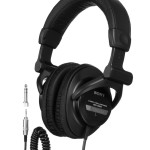 Sony MDR-7509HD
Sony MDR-7509HD
Price: Variable ($100 range used, discontinued)
Yes, we’ve put a pair of cans on the list that have been discontinued by their manufacturer. Why? Because they are still readily available, and have been the workhorse headphones for many home studios for years. With a frequency response ranging from 5Hz (yes 5) to 80kHz, the Sony MDR-7509HDs also have the widest frequency range of the models being discussed. What does this really mean? It means that anything the human ear can hear is audible on these. As one would imagine, minute nuances are more present when wearing these headphones. Clarity, comfort and portability make these perhaps the most impressive headphones on this list for the money. As musicians wearing these while tracking, we find that we sometimes will tell the engineer that the tone of what is being recorded still needs tweaking. Nine times out of ten, we’re right. Be careful what you wish for and who you let wear these while tracking or you may find yourself moving microphones, tweaking tones or trying different amps for much longer than necessary. In the home studio where one not only listens back and does mixing, but also needs headphones while tracking drums, bass, guitar or any other loud source, the Sony MDR-7509HDs allow for accurate monitoring while still blocking unwanted noise.
The least expensive pair on the list, but certainly no slouch, is the SRH400, courtesy of Shure. At under $100, you get a surprisingly responsive set of headphones, and comfort in spades. You can certainly tell the difference between these and say, the Grados, for overall sound quality, but getting your feet wet in home recording will be a lot easier if you have something decent to start with, and these blow away the term “decent,” especially in their price range. We also dug the comfort factor in the SRH440s, leaving them on for many hours without any fatigue. While we normally are skeptical when it comes to manufacturer claims, we couldn’t have said it any better than Shure themselves when it comes to these bad boys: “The SRH440 Professional Studio Headphones provide exceptional sound reproduction and comfort. Optimized for home and studio recording, SRH440 headphones reproduce accurate audio across an extended range. Impedance, power handling and sensitivity are all calibrated for professional audio devices such as DJ mixers, mixing consoles, and headphone amplifier. Includes carrying bag and threaded 1/4″ (6.3mm) gold plated adapter.”

